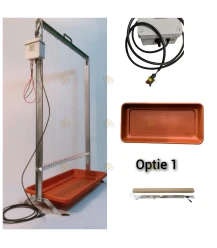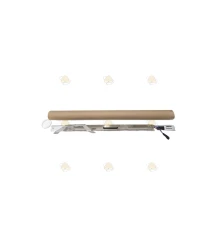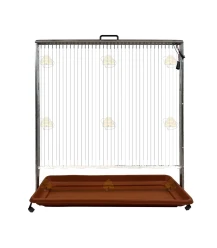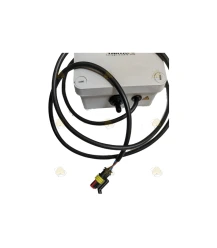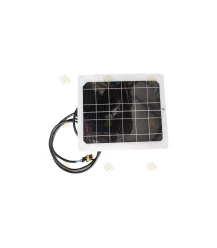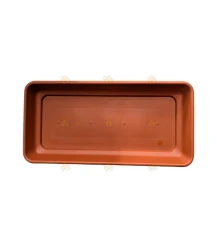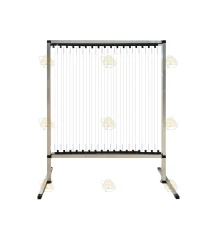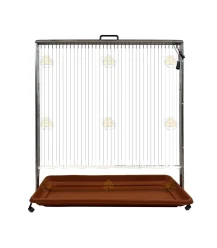Harp traps for Asian hornets
What is an electric hornet harp for controlling the Asian hornet? An electric hornet harp is essentially a square frame strung with wires. These wires have a mesh size of about 18–20 mm, allowing bees to pass through while blocking Asian hornets. The wires are electrified and deliver a shock to the Asian hornet. This stuns the Asian hornet so it drops to the ground, or it may even die on the spot. It works much like an electric fly swatter. In addition, at that moment the Asian hornet releases a pheromone that deters other hornets. This pheromone signals danger and warns others to stay away. It lingers for a short time.
-
Starter Set Stainless Steel/INOX Harp
€ 355,95 In StockWith this complete starter set you’re ready to control and deter the Asian hornet right away. The set includes a high-quality stainless steel (RVS/INOX) harp that you can easily assemble yourself. The harp’s wires are powered by the included USB or solar panel shock unit, so Asian hornets receive a shock and are stunned or killed. The smart design lets...View more -
Harp assembly kit 60 cm - stainless steel/INOX
€ 159,95 In StockThe Harp Kit 60 cm - stainless steel (RVS/INOX) is a complete set to assemble a stainless-steel harp for effective control of the Asian hornet. The durable stainless steel (RVS/INOX) construction provides optimal protection for your beehives. Bees can safely fly through the wires, while hornets are caught and eliminated. The harp requires a shock unit...View more -
Harp kit 80 cm - stainless steel/INOX
€ 189,95 In StockThe Harp kit 80 cm - stainless steel (RVS/INOX) is a complete set to assemble a stainless steel harp for the effective control of the Asian hornet. The sturdy RVS/INOX construction provides durable, reliable protection for your beehives. Bees can safely fly through the wires, while hornets are trapped and neutralized. The harp requires a shock unit (sold...View more -
Harp USB shock device - for stainless steel/INOX Harp
€ 149,95 In StockThe Harp USB shock unit – for stainless steel (INOX) Harp – provides power to the harp wires, allowing you to effectively combat the Asian hornet. When the hornet touches both wires, it receives an electric shock that stuns or disables it. The unit connects easily via USB, but note: the USB power supply is not included and must be purchased separately....View more -
Harp solar-powered energizer - for stainless steel/INOX Harp
€ 175,95 In StockThe Harp solar panel shock unit - for stainless steel (INOX) Harp powers your Harp in an eco-friendly way to effectively combat the Asian hornet. The device generates power via solar energy and keeps the harp wires electrified. When a hornet touches both wires, it receives an electric shock, which stuns or disables it. This unit is ideal for beekeepers...View more -
Water tray/reservoir 80 cm - for stainless steel (INOX) Harp
€ 26,95 In StockThe 80 cm water tray/reservoir – for the 80 cm stainless steel (INOX) harp – is specially designed to sit beneath the harp and collect captured Asian hornets. Once the hornets are neutralized by the electric shock, they fall into the water reservoir where they drown. This reservoir is easy to install and helps boost the harp’s effectiveness by...View more -
Harp assembled - Aluminium
€ 119,95 In StockThe Harp, pre-assembled – Aluminium, is a ready-to-use solution for the control of the Asian hornet. The main advantage of this harp is that it comes fully assembled, so you can get started right away without spending extra time on assembly. Made of aluminium, this harp provides effective protection for your beehives. Bees can fly safely through the...View more -
Selective harp DIY kit 80 cm - stainless steel/INOX
€ 219,95 In StockThe Harp kit 80 cm - RVS/INOX is a complete set to assemble a stainless steel harp for the effective control of the Asian hornet. What makes this harp special is that it is fitted with a tube on the underside. This allows many other insects to exit, and you can mount a jerrycan or bottle onto it. You can, for example, fit this with a drone excluder so the...View more
Effectiveness of the electric harp at the peak of hornet activity
The electric hornet harp is particularly effective when the Asian hornet needs a lot of protein, typically at the peak of brood nest development, August–October. They will then hunt solitary bees and other insects, but also target beehives, which serve as an easy feeding station for the Asian hornet. By positioning the electric harps in a specific way, many hornets can be caught. They then fall to the ground or into a water tray and drown, reducing predation pressure on the hives.
Placement of the electric harp for optimal capture
The hornet harps are positioned perpendicular to the beehives, with two at the ends and one in the middle of a row of hives, to catch Asian hornets. They receive a shock when flying from hive to hive, something bees do little or not at all. Some beekeepers also place a lure near the harps to attract the Asian hornet and make it fly through.
Components and variants of the electric harp
The electric hornet harp consists of two components: the hornet harp itself and a device that generates the current. There are versions that run on mains power or solar power, and you can add a battery for days with less sun. Accessories also include a water tray in which stunned hornets can drown. The hornet harp is widely used in Portugal, Spain and France and is gaining popularity across the rest of Europe. Other solutions also exist, such as trapping hornets with traps or locating nests and destroying them. If you work with hornets, always use the right protection. Hornets are very different from wasps or bees and require specialized suits and personal protection.
Impact of Asian hornets on bee colonies and the benefit of harps
When a bee colony is attacked by Asian hornets, they will initially catch worker bees in the air or off the landing board. If this continues, the colony will retreat and mount a defense, trying to kill every intruding hornet. This hampers the colony’s food supply. They no longer fly out to forage, which can ultimately lead to the collapse of the colony. The harps help reduce predation pressure. In the final months of the season, a strong colony can sometimes withstand Asian hornets, but even then they can suffer by bringing in too little nutrient-rich pollen, which jeopardizes the colony’s winter survival. Healthy, well-fed winter bees are then not produced.

